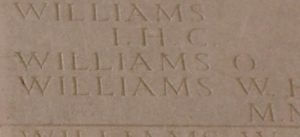Cynwyd is a small village located on the banks of the River Dee, to the south-west of the town of Corwen. The village was part of the ancient county of Merionethshire until 1974 when it became part of Clwyd, and form 1996 became part of Denbighshire. The men, and one woman, of Cynwyd who fell during the Great War are commemorated on the village war memorial, which is situated outside St. John’s Parish Church, and takes the form of a granite cross, standing on an octagonal base. As the village was in Merionethshire at the time of both World Wars, I have placed these details in the Merionethshire section of the website.
The Great War, 1914-1918
Evan Edwards, Private, 4237, Royal Welsh Fusiliers. Evan was the son of John and Margaret Edwards, of 3, The Square, Cynwyd. He worked as an Ironmongers Assistant prior to enlisting at Corwen into the 7th Battalion, Royal Welsh Fusiliers on 10 December 1915 and was posted to Prees Heath for training. Evan was not in khaki for long before he took ill, and he died at Prees Heath Military Hospital of pneumonia and heart failure on 3 March 1916, aged 20. His remains were conveyed home for burial in St. John’s Churchyard, Llangar.
John Evans, Private, 23330, Royal Welsh Fusiliers. John was the son of Edward and Margaret Evans, of Bridge Street, Cynwyd. He worked on his fathers farm prior to enlisting at Bala into the 16th Battalion, Royal Welsh Fusiliers soon after the outbreak of war. The battalion was raised at Llandudno by the Welsh National Executive Committee from a cadre from the 13th Battalion, joining 128 Brigade, 43rd (Welsh) Division and trained in North Wales before moving to Winchester in the summer of 1915, where the formation became renumbered 113 Brigade, 38th (Welsh) Division. The Division moved to France on 2 December 1915 and moved to the Nursery Sector near Fleurbaix for trench initiation alongside the Guards Division. The Division then held a sector of the line near Cuinchy before marching south to the Somme sector in June 1916 to take part in the assault on Mametz Wood. The first attack on the wood was launched on a two-battalion front on 7 July, but failed, and the Divisional Commander, Sir Ivor Philipps, was replaced before the Division attacked again on a two Brigade front on 10 July 1916. John was killed in action during the second day of fighting within the wood, on 11 July 1916, aged 22. He has no known grave and is commemorated on the Thiepval Memorial, France.
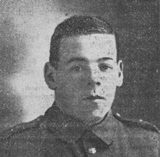
Robert Edward Griffiths, Private, 54721, Royal Welsh Fusiliers. Robert was the son of Thomas and Jane Griffiths, of Ty Mawr, Cynwyd. In March 1916 Robert appealed against conscription at the Corwen Military Tribunal, but his appeal was dismissed, and he then enlisted at Dolgellau into the 7th Battalion, Royal Welsh Fusiliers. After completing his training, Robert was posted to France in the summer of 1916, joining the 10th Battalion, Royal Welsh Fusiliers, which was attached to 76 Brigade, 3rd Division. He most probably joined the battalion following its epic fight in Delville Wood, where it had gained the award of two Victoria Crosses. Following further heavy fighting at Chimpanzee Trench on 18 and 19 August, the battalion was relieved from the front line and the Division began to move back into reserve to rest and rebuild and moved to the Noeux les Mines area before taking up a section of the front at Loos. By the middle of September, the Division had moved back to the Somme, and was at Bertrancourt training. On 12 November the Division moved back into the line to take part in the Battle of the Ancre, which was to be launched the following morning, and the 10th RWF moved into the front line at Serre, ready for the off. The battalion attacked the Germans at Serre the following morning, and heavy fighting raged throughout the day, but heavy casualties were suffered, with around 300 men killed, wounded or missing. Robert was among a large number of men wounded and taken prisoner during the opening of the Battle of the Ancre on 13 November 1916. He was sent to a POW camp near Sprottau, in east Germany, where he recovered of his wounds, but sadly became ill and died on 28 April 1917, aged 20. He is buried in Berlin South-Western Cemetery, Germany.
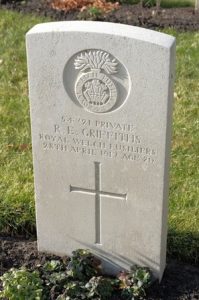
Herbert John Hill, Private, 345702, Royal Welsh Fusiliers. Herbert was the son of Joseph and Elizabeth Hill, of Brynllwyn Lodge, Llangar. He married Elizabeth Ann Edwards (nee Dyas), a widow, at St. John’s Church, Llangar on 11 October 1915. Herbert worked as a driver for Mr. H. R. Jones, Ironmonger prior to the war. Herbert enlisted into the 3rd Battalion, Royal Welsh Fusiliers at Wrexham on 2 November 1916 and after completing his training was posted to Egypt, embarking at Southampton on 25 February 1917, to join the 24th Battalion, Royal Welsh Fusiliers. The battalion formed in Egypt on 1 March 1917 from the Denbighshire Yeomanry, joining 231 Brigade, 74th (Yeomanry) Division. On 19 May 1917 Herbert was standing in a group of other soldiers from his new battalion, when another soldier, Private Riley, accidentally discharged his rifle, which had a live round chambered in it. The bullet went through Herbert, killing him instantly, and struck another man behind him. A subsequent court of enquiry found that the other soldier’s rifle was faulty, and that the safety catch did not work. Herbert was 25 years old when he was killed that day and was buried with full military honours in a small cemetery near Gaza. His grave was moved after the war into Gaza War Cemetery.
David Jones, Private, 60238, Welsh Regiment. David was the son of Ebenezer and Margaret Jones, of Pont Felin, Rhug. He worked as a groom at Rhiwlas, Bala prior to enlisting at Bala into the 3rd Battalion, Welsh Regiment on 9 December 1915 and was placed on the army reserve. David then became a groom at Plas Isa, and lived at Alwen Cottages, Cynwyd whilst awaiting his call up. On 11 June 1917 David was called up for service and on 16 October 1917 arrived in France, initially destined to join the 16th Battalion, Welsh Regiment. He was, however, posted to the 13th Battalion, Welsh Regiment on 23 October 1917, joining up with the battalion in the Fleurbaix sector, where it was attached to 114 Brigade, 38th (Welsh) Division. The battalion was carrying out the normal routine of trench rotation in the Boutillerie Subsector when David arrived and was enjoying several weeks of relative peace, with some intermittent shelling being the only real issue. On 3 December 1917 David was part of a ration party, bringing food up to men in the trenches when he was hit in the stomach by a stray bullet and died. He was 23 years old and was buried by his comrades in Rue-Petillon Military Cemetery, Fleurbaix, France.
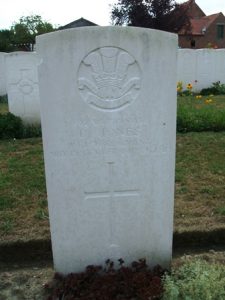
Evan Jones, Private, 2075, Australian Infantry. Evan was the son of Evan and Margaret Jones, of Blaengwnodl, Cynwyd. He had emigrated to Australia prior to the war and found work as a Tram Conductor at Sydney. He enlisted at Newcastle, NSW into the 3rd Reinforcements for the 30th Battalion, Australian Infantry on 22 September 1915 and embarked for Egypt, joining the 30th Battalion at Zeitoun, where it formed part of the 8th Brigade, 5th Australian Division. On 16 June 1916 the battalion embarked at Alexandria for France and entrained at Marseilles for Northern France, taking over a sector of the front near Fleurbaix. The first major battle that the Division took part in was the diversionary attack at Fromelles on 19 July, which turned into a disaster. Evan was shot in the arm at Fromelles and was evacuated to the 3rd Canadian General Hospital at Boulogne, before being brought back to Southall Hospital in England. On 10 November 1916 he was discharged from hospital and granted leave, returning home to visit his family before re-joining the Australian Depot at Perham Down two weeks later. Evan became ill whilst training on Salisbury Plain, and died of bronchitis at the Military Hospital, Fovant on 8 December 1916, aged 27. Evan was buried with full military honours in Compton Chamberlayne Cemetery, Wiltshire.
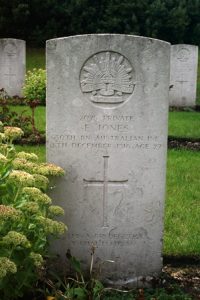
Griffith Thomas Jones, Private, 28268, Royal Welsh Fusiliers. Griffith was the son of Evan and Martha Jones, of Hafod Yr Afr, Llangar, Corwen. He had worked as several local farms prior to the war. Griffith enlisted at Corwen into the Royal Welsh Fusiliers along with his brother Robert on 1 February 1915 and was posted to the 19th Battalion, Royal Welsh Fusiliers. The battalion was raised in March 1915 by the Welsh National Executive Committee as a bantam Battalion and was attached to the 38th (Welsh) Division until August 1915, when it was transferred to 119 Brigade, 40th (Bantam) Division. Griffith embarked at Southampton with the battalion on 1 June 1916, and the entire Division then assembled before moving to the Loos sector. Griffith was shot in the arm on 5 August and evacuated to the 3rd Canadian General Hospital at Boulogne. He re-joined the battalion at Maroc on 15 September, prior to the Divisions move south to the Somme, wintering in the area. Griffith was hospitalised again in February 1917, suffering from trench feet, and returned to Britain to recuperate. He returned to France on 15 June 1917 and was posted to the 1st Battalion, Royal Welsh Fusiliers, which was attached to 22 Brigade, 7th Division. The Division was in the Arras sector, near Bullecourt and by 31 August had moved out of the line. By 29 September the Division had completed its move to the Ypres Salient, and the following day the 1st RWF was in Polygon Wood, preparing to take part in the final stages of the Passchendaele offensive, but became caught up in a German counter-attack. The battalion suffered a terrible 11-day tour in the front line until being relieved and had several days rest before taking up the line again North of the Menin Road on 25 October, and saw more fighting over the coming days. Griffith was killed in action on 28 October 1917, just before the battalion was relieved again. The 24-year-old has no known grave and is commemorated on the Tyne Cot Memorial, Belgium. His brother, Robert Samuel Jones, died of wounds the following year.
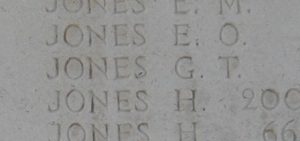
Jane Ellen Jones, Nurse, British Red Cross. Jane was the daughter of Evan Davies Jones and Margaret Jones, of Tan yr Allt, Cynwyd. She worked as a Maid at Ty Nant Farm, Corwen prior to the war, then volunteered to work for the Red Cross, at the Hospital in Ashton-under-Lyne. Jane worked in the hospital for much of the war, and after the Armistice passed her exams, becoming a fully qualified nurse. Sadly, she took ill soon after and died in the hospital on 12 February 1919, aged 25. Little else is currently known of her, as she is not commemorated by the CWGC.
John Jones, Private, 36136, Royal Welsh Fusiliers. John was the son of Elizabeth Jones, of Tanyrochr, Cynwyd. He worked as a Carter in Bootle prior to the war and lived at 38, Enid Street, Liverpool. John enlisted at Liverpool into the 3rd Battalion, Royal Welsh Fusiliers in 1 October 1915, and was posted to the Depot at Wrexham. On 24 February 1916 he embarked for France, and was sent to the 19th Infantry Base Depot at Étaples. On 10 March 1916 he was posted to the 9th Battalion, Royal Welsh Fusiliers, which was attached to 58 Brigade, 19th (Western) Division. He joined up with the battalion in reserve at Croix Marmeuse, just before it moved back into the line in the Neuve Chapelle sector. On 15 April the Division moved out of the line into reserve and moved to the First Army Training Area at Serny. On 8 May the Division began making a series of moves which brought it down to the Somme sector and by 30 June 1916 was in place at Albert, ready to take part in the Somme offensive. The Division fought throughout much of the Somme offensive over the coming days, before beginning its move north at the end of July, eventually taking over a section of the front in the Ploegsteert area. John spent much of this time in and out of hospital, suffering from various ailments. By May the Division was in the Hooge sector, and the 9th RWF was in support, with two Companies in Ypres, one at Maple Street and one at Ritz Street. John was among five men killed and seven wounded whilst his Company was in reserve in Ypres on 12 May 1917. The 25-year-old is buried in Vlamertinghe Military Cemetery, Belgium.
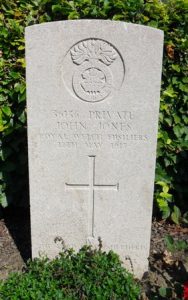
Robert Samuel Jones, Private, 28269, Royal Welsh Fusiliers. Robert was the son of Evan and Martha Jones, of Hafod yr Afr, Cynwyd. He worked as a farm labourer prior to the war. Robert enlisted at Corwen into the Royal Welsh Fusiliers along with his brother Griffith on 1 February 1915 and was posted to Llandudno where he joined the 19th Battalion, Royal Welsh Fusiliers. The battalion was raised in March 1915 by the Welsh National Executive Committee as a bantam Battalion and was attached to the 38th (Welsh) Division until August 1915, when it was transferred to 119 Brigade, 40th (Bantam) Division and moved to France on 1 June 1916. Robert remained behind, posted to Kinmel Park to the reserve units, and did not embark for France until 15 August 1917. He was posted to the 5th Infantry Base Depot at Rouen, and on 30 August 1917 was posted to the 2nd Battalion, Royal Welsh Fusiliers. The battalion was attached to 19 Brigade, 33rd Division and Robert joined the battalion at Moulle on 1 September. The Division moved to Ypres soon afterwards, and Robert saw his first action during the assault on Polygon Wood on 26 September. The Division fought at Ypres throughout the remainder of the Passchendaele offensive. In December 1917 Robert cut his knee on some German barbed wire, whilst on a working party. The wound became septic and he was hospitalised for several weeks, before being posted to the Infantry Base Depot at Boulogne. It was not until 21 August 1918 that Robert re-joined the battalion, which by now was attached to 115 Brigade, 38th (Welsh) Division. The Division had launched an offensive across the flooded Ancre Valley on 21 August and began driving its way forward towards the Hindenburg Line. Robert had not been back in action long when he was badly wounded during heavy fighting at Lesboeufs on 1 September. He was evacuated to the 29th Field Ambulance where he died of his wounds on 20 September 1918, aged 21. He is buried in Bagneux British Cemetery, Gézaincourt, France. His brother, Griffith Thomas Jones, was killed the previous year.
Thomas Jones, Private, 20378, Royal Welsh Fusiliers. Thomas was the son of David and Mary Jones, of Ty’n y Fedw, Cynwyd. He enlisted at Corwen into the 14th Battalion, Royal Welsh Fusiliers soon after the outbreak of war. The battalion was raised at Llandudno by the Welsh National Executive Committee as part of 128 Brigade, 43rd (Welsh) Division. On 29 April 1915 the formation became renumbered 113 Brigade, 38th (Welsh) Division, and on 2 December 1915 landed in France. The Division moved to the Fleurbaix sector for trench initiation alongside the Guards Division, before taking over a section of the front, near Cuinchy. On 2 June 1916 the 14th RWF relieved the 13th RWF in the front line at Winchester Post, to begin a short rotation in the line, and to carry out wiring work in No Man’s Land. The battalion came under heavy shellfire during the day, suffering a number of casualties, so on the following night the Divisional artillery retaliated by firing a heavy bombardment upon the Germans. Thomas was wounded during this horrific spell in the trenches, and died of his wounds on 5 June 1916, aged 28. He is buried in Merville Communal Cemetery, Nord, France.
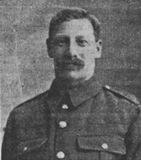
David Roberts, Private, 39741, Royal Welsh Fusiliers. David was born on 19 October 1882, the son of William and Elizabeth Roberts, of Ty’n y Siglen, Cynwyd. He worked for the Great Western Railway at Wolverhampton, Corwen and in their Warehouse in Brymbo, before moving to Birkenhead to work in their cotton warehouse. David enlisted at Birkenhead into the Royal Welsh Fusiliers on 20 March 1916, and was posted to the Depot at Wrexham. He joined the 12th Battalion, Royal Welsh Fusiliers at Kinmel Park on 25 March, and after completing his training was posted to the Infantry Base Depot in France on 15 July. David was initially destined for the 10th RWF, but on 27 July was instead posted to the 2nd Battalion, Royal Welsh Fusiliers, which was attached to 19 Brigade, 33rd Division. David joined up with the battalion on the coast, at Airaines. The Division entrained for Dunkirk on 31 July to prepare to launch an offensive along the coast, but when the Passchendaele offensive ground to a halt in the mud, the operation was called off, and the 33rd Division moved to Ypres on 15 September. David saw his first major action during the Divisions attack on Polygon Wood on 26 September, where it suffered terrible casualties. The 2nd RWF then enjoyed a short rest before moving with the Division to Messines, and supplied working parties to Ypres over the coming weeks. On 30 October 1917 the 2nd RWF moved back into the line, relieving the 1st Argyle and Sutherland Highlanders in the Messines Left Subsector. David was killed in action during the relief that day. The 34-year-old has no known grave and is commemorated on the Tyne Cot Memorial, Ypres.
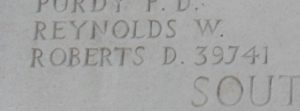
David Roberts, Private, 29449, Royal Welsh Fusiliers. David was the son of Griffith and Jane Roberts, of The Square, Cynwyd. He worked as a Carter prior to enlisting at Corwen into the 21st Battalion, Royal Welsh Fusiliers on 17 November 1915 and joined the battalion at Kinmel Park. He was then posted to the 19th Battalion, Royal Welsh Fusiliers, which was at Aldershot attached to 119 Brigade, 40th (Bantam) Division. The Division embarked for France early in June 1916 and moved to the front near Loos. Late in 1916 it moved south to the Somme, taking part in the Battle of the Ancre, and remained in the area over the winter, before following the German retreat to the Hindenburg Line in March 1917. The Division took part in the Battle of Cambrai later in the year, and attacked the massive Bourlon Wood on 23 November 1917. The artillery barrage for the attack began at 10.30 and the 19th RWF and 12th SWB entered the wood shortly after, initially meeting light resistance. Fighting then got harder as the battalions advanced deeper into the wood, but within two hours the northern edge had been reached. The Germans counter-attacked several times during the night, but were repulsed each time. At 09.00 the Germans launched a massive counter-attack from the direction of Bourlon village, and the 40th Division came under intense pressure, suffering terrible casualties. David was killed in action within the wood this day, 24 November 1917, aged 33. He has no known grave and is commemorated on the Cambrai Memorial, Louverval, France.
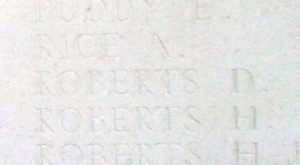
Hugh David Williams, Private, 40791, Royal Welsh Fusiliers. Hugh was the son of Moses and Margaret Williams, of Pant y Clai, Cynwyd. He worked as a Draper in the Army and Navy Stores in London for almost eighteen years prior to the war. Hugh enlisted at Kingston-on-Thames into the Royal Welsh Fusiliers in April 1916 and was posted to Kinmel Park for training. Hugh was posted to France late in 1916, joining the 13th Battalion, Royal Welsh Fusiliers, which was attached to 113 Brigade, 38th (Welsh) Division, and was holding the line in the Canal Bank sector, north of Ypres. The Division had moved here following its success at Mametz Wood in July 1916, and held this section of the line until launching its assault on the Pilckem Ridge on 31 July 1917, as part of the opening phase of the Third Battle of Ypres. The assault was a success, and the Division captured Iron Cross and the Pilckem Ridge, making their way to the Steenbeek, facing Langemarck. Following its success at Ypres, the Division was moved to the Erquinghem sector in September. It remained in the area until the end of March 1918, when it was moved south to relieve the battered 2nd and 47th Divisions in the line north of Albert, following the launching of the German Spring offensive. It remained here until launching its assault across the flooded Ancre valley on 21 August, capturing Thiepval Ridge before beginning the advance towards the Hindenburg Line. Hugh was killed during when the 13th RWF launched a successful, but costly, assault on the line running from Crucifix Corner, Aveluy Wood to the Albert to Bapaume road on 23 August 1918. The 38-year-old has no known grave and is commemorated on the Vis-en-Artois Memorial, Haucourt, France.
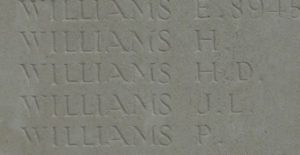
Owen Williams, Private, 44567, South Wales Borderers. Owen was the son of Jane Williams, and the brother of John D. Williams, of The Square, Cynwyd. He worked as a farm labourer at Oswestry prior to the war. Owen enlisted at Corwen into the Royal Welsh Fusiliers, and was sent to Kinmel Park for training. He was posted to France late in 1916, joining the 2nd Battalion, South Wales Borderers. The battalion was attached to 87 Brigade, 29th Division, and had suffered terrible casualties during its assault on Y-Ravine on the opening morning of the Somme offensive. The Division then moved to the Ypres Salient to rest and rebuilt, before moving back to the Somme by 13 October 1916 and took part in the capture of the ruined village of Gueudecourt, as part of the great Battle of Le Transloy. The division remained in the Somme sector following the closure of the Somme offensive, and wintered there in terrible conditions. On 4 February 1917 the 2nd SWB were in the trenches at Guillemont, when the Germans opened up a terrible artillery barrage along their positions. Owen was killed during the barrage that day. The 43-year-old has no known grave and is commemorated on the Thiepval Memorial, France.
